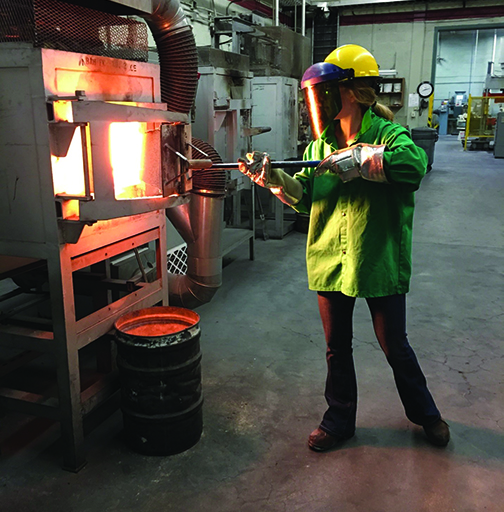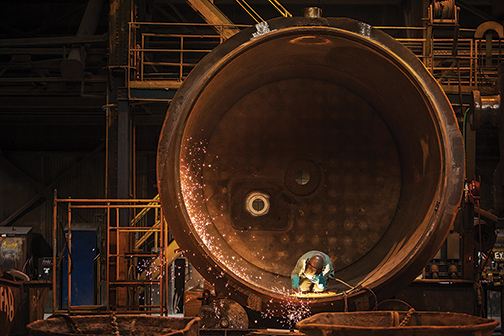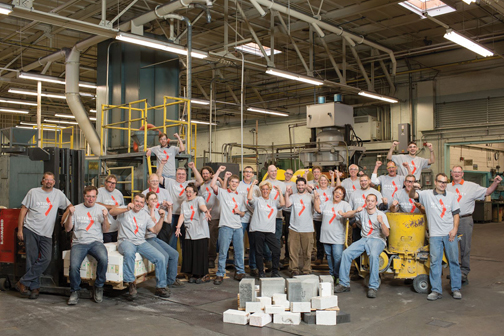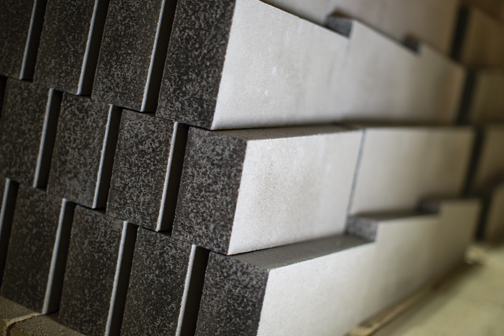 It’s almost impossible to imagine a world without modern buildings, bridges, cars, roads, windows, computers, food packaging or countless other essential items in our daily lives. However, if not for refractories, these items would not exist. The world as we know it would be very different! Based in Pittsburgh, PA, HarbisonWalker International is the largest supplier of these vital refractory products and services in the United States.
It’s almost impossible to imagine a world without modern buildings, bridges, cars, roads, windows, computers, food packaging or countless other essential items in our daily lives. However, if not for refractories, these items would not exist. The world as we know it would be very different! Based in Pittsburgh, PA, HarbisonWalker International is the largest supplier of these vital refractory products and services in the United States.
Derived from the Latin word, ‘refractarius,’ meaning stubborn, refractories are essential protectants for all heat-intensive production processes, including iron and steelmaking, cement production, glass, ceramics, aluminum, nonferrous metals, paper and pulp, petrochemical processing, power production and waste incineration. Many of the world’s leading companies in these industries are the valued customers of HWI.
 Refractories are ceramic materials made using clay and other minerals, and the company’s earliest products used clay from nearby Bolivar, PA, to make its first “fire bricks.” Today, customers’ requirements vary between pre-formed brick and monolithic products, depending on the application. The monolithic products can be shaped into countless forms or even sprayed on surfaces that require protection.
Refractories are ceramic materials made using clay and other minerals, and the company’s earliest products used clay from nearby Bolivar, PA, to make its first “fire bricks.” Today, customers’ requirements vary between pre-formed brick and monolithic products, depending on the application. The monolithic products can be shaped into countless forms or even sprayed on surfaces that require protection.
While the use of refractory materials is almost as old as fire itself, the modern U.S. refractories industry was born in Pittsburgh nearly 160 years ago when the Star Fire Brick Company was founded in 1865. Today it has evolved to become HWI. Its international network spans North America, Europe and Asia, with 18 manufacturing plants, 20 Global Sourcing Centers and technology facilities in both the United States and China.
One of Pittsburgh’s Early Industrial Giants
The company took on a version of its current name in 1875 when ambitious employee Samuel Harbison partnered with stockholder Hay Walker to buy the Star Fire Brick Company and form Harbison Walker Refractories.
 The fledgling company landed a contract from Kloman, Carnegie, and Company to build the Lucy Furnace, which at the time was the largest steelmaking blast furnace ever built. It put Pittsburgh — and Andrew Carnegie — on the map for the rest of history! To this day, the steel industry is the largest consumer of refractories.
The fledgling company landed a contract from Kloman, Carnegie, and Company to build the Lucy Furnace, which at the time was the largest steelmaking blast furnace ever built. It put Pittsburgh — and Andrew Carnegie — on the map for the rest of history! To this day, the steel industry is the largest consumer of refractories.
In fact, HWI’s history is inextricably linked to those of the steel industry giants. In 1901 — one year after Andrew Carnegie’s company became the U.S. Steel Corporation — Harbison Walker Refractories increased its holdings to 33 plants and thousands of acres of clay mines, including many across Pennsylvania. Every step of the way, Harbison Walker made investments to enable the Industrial Revolutionists’ visions to become a reality.
By the 1960s, Harbison Walker had acquired several foreign companies, but the company merged and became a division of Dresser Industries of Dallas in 1967. Over the next several decades, it would go through many ownership transitions. The company rebranded in 2015 to become HarbisonWalker International.
A Customer-Focused Culture of People and Innovation
In 2021, HWI is a thriving company of 1,300 employees who share the vision of being the first and only call its customers need to make. Over the last several years, the company has made significant investments in its people, processes and products. It has completely transformed virtually all its operations to deliver 21st century, world-class solutions for customers across all industries and geographic locations.
 These solutions include high-level services for refractory customers. HWI’s Value-Added Service teams provide on-site management, installation, equipment, inventory management, heating solutions and testing for customers across all industries. VAS also provides analytic capabilities that enable customers to maximize uptime and efficiency. The company’s Global Projects and Engineering Team specializes in greenfield construction, manufacturing, plant modernization and servicing the advanced engineering needs of existing facilities.
These solutions include high-level services for refractory customers. HWI’s Value-Added Service teams provide on-site management, installation, equipment, inventory management, heating solutions and testing for customers across all industries. VAS also provides analytic capabilities that enable customers to maximize uptime and efficiency. The company’s Global Projects and Engineering Team specializes in greenfield construction, manufacturing, plant modernization and servicing the advanced engineering needs of existing facilities.
Today’s refractories are sophisticated, highly engineered materials customized for the environments where customers will install them. HWI produces hundreds of different products and holds patents on many of the industry’s most popular and respected refractory solutions. Last year, HWI shipped more than 130 million pounds of refractory materials from its Global Sourcing Centers to customers worldwide. Last year, it also completed an ambitious, cloud-based digital transformation of its entire supply chain and commercial operations to manage orders and serve customers more effectively.
The company recently built the most advanced refractory facility in North America and, perhaps, in the world. Opened in 2017, HWI’s South Point, Ohio monolithics plant features new state-of-the-art processes and technology. It utilizes lean manufacturing techniques throughout its operations to maximize material flow efficiency and production. HWI has also made capital investments to physically expand and integrate technology into several other existing plants over the past few years.
Advanced Refractories Technology and Research Starts in Pennsylvania
 Although HWI products are produced at facilities globally, much of the innovation and product development starts just outside of Pittsburgh in West Mifflin, PA, at HWI’s Advanced Technology and Research Center.
Although HWI products are produced at facilities globally, much of the innovation and product development starts just outside of Pittsburgh in West Mifflin, PA, at HWI’s Advanced Technology and Research Center.
The ATRC is the largest refractories research laboratory in North America and is known internationally in the industry. From 2018 to 2020, the team at HWI’s ATRC launched 42 new products. In 2018 alone, it put four new U.S. patents in process. HWI’s numerous registered trademarks are recognized and trusted around the world.
The innovation underway at ATRC often centers on products, but it also can include new processes, new packaging or new application methods. The team also tackles new ways to install refractory products or identify new raw materials that enable new refractory performance parameters or lower the cost of products without sacrificing performance.
In addition to physical expansion and technology integration in its plants, HWI is evolving the refractory industry for the 21st century by taking a holistic approach to advancing its use of data. It is aggressively initiating programs to help customers transition numerous decision-making processes from experienced-based to data-based. For customers, the data translates into process improvements and business intelligence that help customers become smarter, safer and even more efficient with knowledge-sharing in their own organizations.
The primary goal of innovation at ATRC is to solve customers’ problems and bring added value to the products and services that HWI delivers to customers. At the ATRC and all its locations, the company recognizes that delivering for customers would not be possible without its employees. People are HWI’s most important asset, and the company is continuously investing in its people to ensure it is a world-class employer and a great place to work.
Across all operations, HWI’s singular, intense focus on anticipating, delivering and responding to customers unifies its team and continues to drive innovation. This forward-thinking approach is also fueling the company’s employee-led Environmental, Social, and Governance, or “ESG,” journey, launched this year to ensure that HWI will be a thriving, responsible, and sustainable business for its next 150+ years of operations.